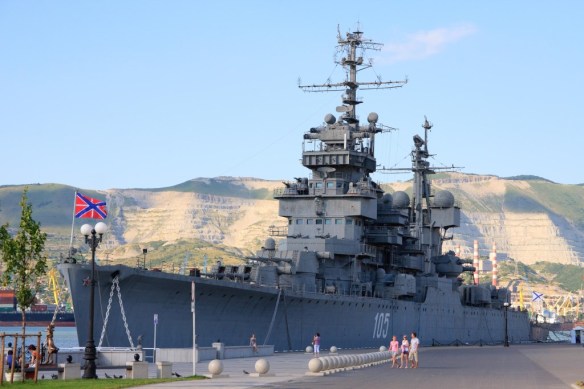Technical data of the light cruiser designs
In the ten-year programme of November 1945 there were besides the five prewar cruisers of projekt 68K25 new light cruisers planned. They were intended for classic cruiser tasks, defending the fleet against surface and air torpedo attacks, covering convoys, undertaking raiding operations and laying minefields. The Navy had first issued a TTZ for a cruiser of 8,000-8,500t stdd., with 152mm guns. But when the TsKB-17 worked on such a ship it soon became much bigger and reached between 14,500 and 18,000t, and it was suggested that the ships be armed with 180mm guns instead of the 152mm. In 1947 the TsKB-17 developed no less than 40 variants of the projekt 65 cruiser with 12,800-16,850t and three or even four triple turrets of 180mm guns to be superior to the latest US cruisers of this type, the Worcester, and the British Superb, or to be armed with nine 152mm dual-purpose guns. But Stalin did not like this project, and during a meeting at the Kremlin in 1947 it was cancelled, and Stalin wanted to have the new light cruisers built as improvements of the projekt 68K, using the proven systems and some of the German developments in fire control and stabilized 100mm dual-purpose guns.
The design work was done at the TsKB-17 by A.S. Savichev, and on 27 May 1947 the projekt 68-bis was approved for series production, and the first three orders went out on 3 December 1947 to the yards No. 189 and No. 194 at Leningrad and No. 444 at Nikolaev, using the names of the laid-down but not completed ships of the pre-war design projekt 68: Sverdlov, Dzerzhinskii and Ordzhonikidze. The Dzerzhinskii was the first to be laid down at Nikolaev on 21 December 1948, followed in October 1949 by the other two ships. During 1948–53 18 more orders followed, eight to the No. 189 yard at Leningrad, five to yard No. 194 at Leningrad, of which two should be sent to Molotovsk, three to yard No. 444 at Nikolaev, and two to yard No. 402 at Molotovsk. One more of each were planned to be ordered in 1954 for each of the four yards. The Ordzhonikidze yard 189 built – besides the Sverdlov, which was commissioned in May 1952 and surprised the public in the Western countries when it appeared at the coronation parade at Spithead in June 1953 – four more which were commissioned from December 1952 to December 1954: Zhdanov, Admiral Ushakov, Aleksandr Suvorov, and Admiral Senyavin. The Marti yard No. 194 at Leningrad completed two more ships in 1952 and 1953: Aleksandr Nevskii and Admiral Lazarev, the Marti yard No. 444 at Nikolaev in 1953 and 1954 also completed two, the Admiral Nakhimov and Mikhail Kutuzov, and finally yard No. 402 at Molotovsk two ships in 1954 and 1955, the Molotovsk and Murmansk (ex-Kozma Minin).
After the completion of the first 14 ships it was planned to complete the other 11 vessels to a changed design as projekt 68-bis-ZIF with a changed A/A armament and protection against a radioactive fallout. But after Stalin’s death in March 1953 it was decided not to lay down the last four vessels, which were planned to be ordered in 1954 with one unit for the four yards. But in early 1956 the decision was taken to stop the construction of the incomplete vessels, which were in the meantime planned to be rebuilt to projekt 75. So the Kronshtadt, Tallinn and Varyag, laid down in 1953 and early 1954 at No. 189, the Shcherbakov, laid down already in 1951 at No. 194, the Admiral Kornilov, laid down in 1951 at No. 444, and the Arkhangelsk and Vladivostok, laid down in 1954 at No. 402, were laid up and from 1959 to 1961 scrapped. The Kozma Minin and the Dmitrii Pozharskii, laid down in 1952/53 at No. 194, were sent in sections to No. 402 to be used for the Molotovsk (renamed Oktyabrskaya revolyutsiya in 1957) and the Murmansk under construction.
From the mid-1950s there were many plans to rebuild some of the aforementioned cruisers into anti-aircraft vessels armed with rockets and others to be armed with cruise missiles, as is mentioned later. A new projekt 84 light cruiser, for which an OTZ was issued in 1955, was not realized.
Sverdlov Class
Type and Significance: These light cruisers were among the world’s last vessels whose armament was composed solely of guns.
Dates of Construction: Laid down between 1949 and 1954, with the last being completed in 1955.
Hull Dimensions: 689’ x 72’ 2” x 24’ 7”
Displacement: 16,000 tons
Armor: A belt with a maximum thickness of 5 inches, a deck that varied between 3 inches and 1 inch in depth, and 5-inch turret armor.
Armament: 12 5.9-inch guns in four triple gunned turrets, two each being located fore and aft, 12 3.9-inch guns, antiaircraft weapons, and 10 20.8-inch torpedo tubes.
Machinery: Turbines fed by six oil-fired boilers that could produce 110,000 horsepower.
Speed: 32.5 knots
Complement: 1,010
Summary: These ships engendered alarm in the naval officials of the Western powers, as they were perceived as significant threats. Although powerful in appearance, however, the Sverdlov-class cruisers were rendered largely obsolete by the beginning of the missile age. The Admiral Nakhimov and Dzerzhinski were refitted in the late 1950s to test early Soviet SSM batteries. The former unit was scrapped in 1961. The Ordzhonikidze was sold to Indonesia the following year and sold for scrap in 1972. All the other units except one were scrapped by 1994. The Mikhail Kutuzov was put in reserve in 1989 and remains in that status.
